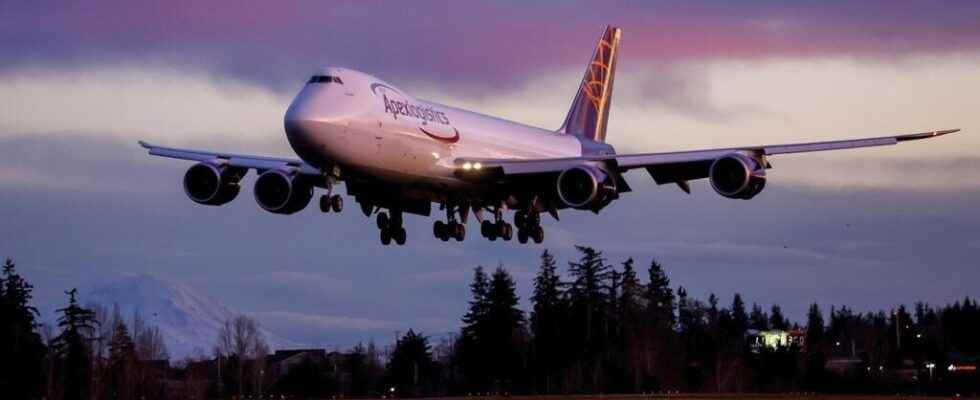The American aircraft manufacturer Boeing is delivering its last 747 this Tuesday, January 31. Fifty-four years after its first flight, the “Jumbo Jet” is gradually bowing out. If it is now supplanted by other models, the Boeing 747 will retain a special place in the history of civil aviation. It is the plane that democratized air transport among the middle classes.
With its disproportionate size, it has long distinguished itself in the fleet of civilian aircraft. It is not for nothing that it was nicknamed “Jumbo Jet” or “Queen of the skies” (“Queen of the skies”). He was also the flagship of Boeing, the plane that brought him worldwide fame. And after more than half a century, here it begins its descent for good.
The 747, legendary airliner, is delivered for the last time on January 31. The aircraft was handed over to Atlas Air. It is the 1,574th and last Boeing 747 built. The American group had announced, in July 2020, the end of long-haul production.
The time has come. The 747 is certainly not going away for a while. Whether in its passenger version or in its cargo version, the aircraft will still fly for a few decades. But the end of production marks a turning point in the history of civil aviation. Just as was its creation and especially its marketing.
The first giant of the air
In the 1960s, aircraft manufacturers faced an increasingly large influx of travelers. Seeing the world becomes popular, and Pan American World Airways (Pan American) asks Boeing to design an aircraft that can meet this demand and carry passengers in droves.
The International Air Transport Association (IATA) recounts, in its own version, the exchange at the end of which the agreement was concluded between Juan Trippe, CEO of Pan American, and Bill Allen, his counterpart of Boeing. ” If you build it, I buy it “, would have said the first. ” If you buy it, I build it “, would have answered the second. In 1967, production began.
To build its 747, Boeing must first have a gigantic factory in Everett, in the suburbs of Seattle (Washington State). The place remains, to this day, the largest building in the world by volume, with its 13.4 million m3 and its area extending over 40 hectares. Some 50,000 employees – who will call themselves “The Incredibles” – are mobilized to build the first device, assembled in the space of 16 months.
The plane is out of the ordinary. The engineers opted for a wide model, equipped with four reactors and two corridors. The goal has been achieved: the 747 can carry more than 600 passengers in its largest configuration. Respecting the demands of Pan American, it is also ideal for transporting large industrial parts. With its cockpit installed high up, its hump-shaped nose and of course its dimensions, it does not go unnoticed.
The first flight took place on February 9, 1969. And on January 22, 1970, Pan American made its first commercial flight with the 747, between New York and London. It was supposed to take place the day before, but a technical problem led to a postponement of a few hours.
Knocked out by less greedy competitors
A juggernaut of the air, the Boeing 747 is a game-changer in the world of air transport. This long-haul, which will see improvements over the years, is the star aircraft for years. With its large capacity and popularity, ticket prices are dropping. Air travel is no longer reserved for the elite. The middle classes can more easily discover the world in turn.
It was only at the end of the 1990s that its influence decreased. Companies are starting to turn to more innovative, less fuel-intensive and easier-to-handle aircraft. The 747 implies that airports have enough space to accommodate it. On April 27, 2005, the “Jumbo Jet” lost its title as the largest passenger aircraft when the European aircraft manufacturer Airbus made the first flight, in Toulouse, France, of the new A380.
One after the other, the companies stop using the 747. Thus, this plane has not flown in the United States since 2017, except for the two Air Force One aircraft, which have formed the fleet of American presidents since 1990. Two copies 747-8, the latest version concocted in 2011 by Boeing, must also replace those currently in service.
The 747, which would have transported more than 6 billion people according to Boeing, will also remain associated with the two deadliest accidents in civil aviation. On August 12, 1985, a poorly maintained aircraft crashed between Tokyo and Osaka with 524 people on board: only four survived. And on March 27, 1977, at Los Rodeos airport in Tenerife in the Canary Islands, two 747s collided on the runway, after a switching error and when thick fog had set in: 583 people died in this disaster which had a profound impact on air transport.
For Boeing, the after 747 has already begun. The aircraft manufacturer, harmed by the Covid-19 pandemic and by the setbacks of its 737 Max, looks at the aircraft of the future. It has just joined forces with NASA, the American space agency, to develop a sustainable airliner, more environmentally friendly. The two groups are aiming for a new technological revolution and are counting on the start of production in the 2030s. The 747, with its big brother looks from another time, should then still be around a bit.
► To read also: The coronavirus crisis causes heavy losses for Airbus and Boeing
